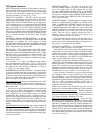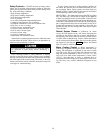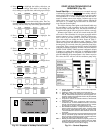
Operation Features:
• 2 chiller lead/lag
• addition of a third chiller for backup
• manual rotation of lead chiller
• load balancing if configured
• staggered restart of the chillers after a power failure
• chillers may be piped in parallel or in series chilled water
flow
COMMON POINT SENSOR INSTALLATION — Lead/
lag operation does not require a common chilled water point
sensor. Common point sensors can be added to the 8-input
option module, if desired. Refer to the certified drawings for
termination of sensor leads.
NOTE: If the common point sensor option is chosen on a
chilled water system, both chillers should have their own 8-input
option module and common point sensor installed. Each chiller
will use its own common point sensor for control, when that
chiller is designated as the lead chiller. The PIC cannot read
the value of common point sensors installed on other chill-
ers in the chilled water system.
When installing chillers in series, a common point sensor
should be used. If a common point sensor is not used, the
leaving chilled water sensor of the upstream chiller must be
moved into the leaving chilled water pipe of the downstream
chiller.
If return chilled water control is required on chillers piped
in series, the common point return chilled water sensor should
be installed. If this sensor is not installed, the return chilled
water sensor of the downstream chiller must be relocated to
the return chilled water pipe of the upstream chiller.
To properly control the common supply point temperature
sensor when chillers are piped in parallel, the water flow through
the shutdown chillers must be isolated so that no water by-
pass around the operating chiller occurs. The common point
sensor option must not be used if water bypass around the
operating chiller is occurring.
CHILLER COMMUNICATION WIRING — Refer to the
chiller’s Installation Instructions or to the Carrier Comfort
Network Interface section on page 48 of this manual for
information on chiller communication wiring.
LEAD/LAG OPERATION — The PIC control provides the
ability to operate 2 chillers in the LEAD/LAG mode. It also
provides the additional ability to start a designated standby
chiller when either the lead or lag chiller is faulted and
capacity requirements are not met. The lead/lag option op-
erates in CCN mode only. If any other chiller configured for
lead/lag is set to the LOCAL or OFF modes, it will be un-
available for lead/lag operation.
NOTE: Lead/lag configuration is viewed and edited in Lead/
Lag, under the Equipment Configuration table of the Service
menu. Lead/lag status during chiller operation is viewed in
the MAINT04 table in the Control Algorithm Status
table.
Lead/Lag Chiller Configuration and Operation — The con-
figured lead chiller is identified when the LEAD/LAG
SELECT value for that chiller is configured to the value of
‘‘1.’’The configured lag chiller is identified when the LEAD/
LAG SELECT for that chiller is configured to the value of
‘‘2.’’ The standby chiller is configured to a value of ‘‘3.’’A
value of ‘‘0’’ disables the lead/lag in that chiller.
To configure the LAG ADDRESS value on the LEAD/
LAG Configuration table, always use the address of the other
chiller on the system for this value. Using this address will
make it easier to rotate the lead and lag chillers.
If the address assignments placed into the LAG
ADDRESS and STANDBYADDRESS values conflict, the lead/
lag will be disabled and an alert (!) message will
occur. For example, if the LAG ADDRESS matches the lead
chiller’s address, the lead/lag will be disabled and
an alert (!) message will occur. The lead/lag maintenance
screen (MAINT04) will display the message ‘INVALID
CONFIG’ in the LEAD/LAG CONFIGURATION and
CURRENT MODE fields.
The lead chiller responds to normal start/stop controls such
as occupancy schedule, forced start/stop, and remote start
contact inputs. After completing start up and ramp loading,
the PIC evaluates the need for additional capacity. If addi-
tional capacity is needed, the PIC initiates the start up of the
chiller configured at the LAG ADDRESS. If the lag chiller is
faulted (in alarm) or is in the OFF or LOCAL modes, then
the chiller at the STANDBY ADDRESS (if configured) is
requested to start. After the second chiller is started and is
running, the lead chiller shall monitor conditions and evalu-
ate whether the capacity has reduced enough for the lead
chiller to sustain the system alone. If the capacity is reduced
enough for the lead chiller to sustain the CONTROL POINT
temperatures alone, then the operating lag chiller is stopped.
If the lead chiller is stopped in CCN mode for any reason
other than an alarm (*) condition, then the lag and standby
chillers are stopped. If the configured lead chiller stops for
and alarm condition, then the configured lag chiller takes the
lead chiller’s place as the lead chiller and the standby chiller
serves as the lag chiller.
If the configured lead chiller does not complete the start-
up before the PRESTART FAULT TIMER (user configured
value) elapses, then the lag chiller shall be started and the
lead chiller will shut down. The lead chiller then monitors
the start request from the acting lead chiller to start. ThePRE-
START FAULT TIMER is initiated at the time of a start
request. The PRESTART FAULT TIMER’s function is to
provide a timeout in the event that there is a prestart alert
condition preventing the chiller from starting in a timely man-
ner. The timer is configured under Lead/Lag, found in the
Equipment Configuration table of the Service menu.
If the lag chiller does not achieve start-up before the
PRESTART FAULT TIMER elapses, then the lag chiller shall
be stopped and the standby chiller will be requested to start,
if configured and ready.
Standby Chiller Configuration and Operation — The con-
figured standby chiller is identified as such by having the
LEAD/LAG SELECT configured to the value of ‘‘3.’’ The
standby chiller can only operate as a replacement for the
lag chiller if one of the other two chillers is in an alarm (*)
condition (as shown on the LID panel). If both lead and lag
chillers are in an alarm (*) condition, the standby chiller shall
default to operate in CCN mode based on its configured
Occupancy Schedule and remote contacts input.
Lag Chiller Start-Up Requirements — Before the lag chiller
can be started, the following conditions must be met:
1. Lead chiller ramp loading must be complete.
2. Lead chiller CHILLED WATER temperature must be greater
than the CONTROL POINT plus 1/2 the WATER/BRINE
DEADBAND.
NOTE: The chilled water temperature sensor may be the
leaving chilled water sensor, the return water sensor, the
common supply water sensor, or the common return
water sensor, depending on which options are configured
and enabled.
3. Lead chiller ACTIVE DEMAND LIMITvalue must be greater
than 95% of full load amps.
35


















